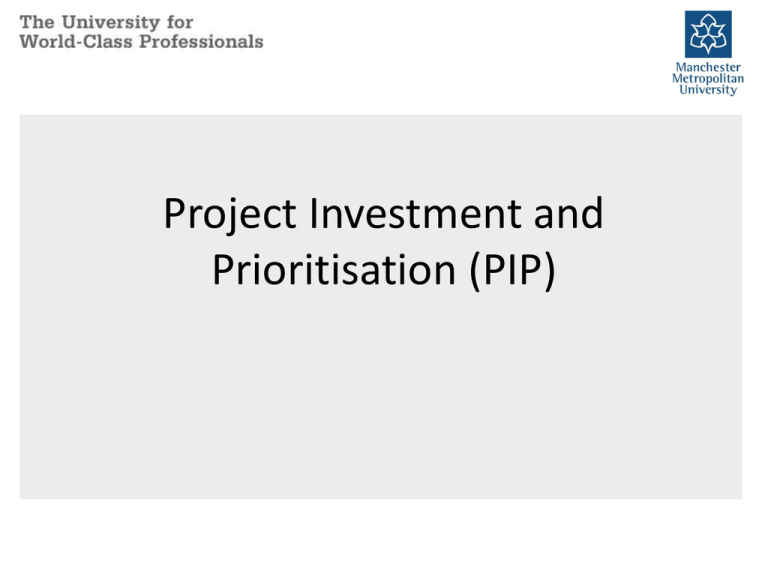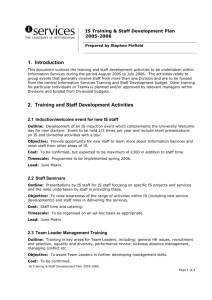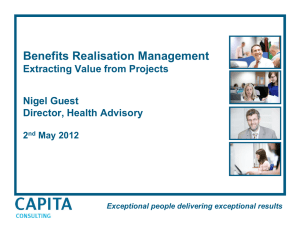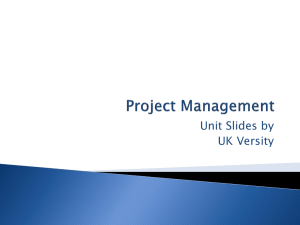PIP Process Briefing
advertisement

Project Investment and Prioritisation (PIP) PIP Process – why is it needed? • Current position: – – – – Lots of projects (over 90 that we know about) Limited resources – we can’t do everything No method to prioritise Leads to delays and frustration • PIP purposes: – Approval process for new and in some cases existing projects – Transparent mechanism for prioritisation – High-level monitoring of project portfolio PIP Process – benefits • The right projects will be delivered at the right time • Limited resources directed to priorities • Improved delivery resulting from better use of resources and project start-up standards • Better overall project governance • Greater transparency: – Which projects are being supported – How projects link to strategy and operations PIP Process – what is included? • Applies to all business change projects with an Information Systems or Technology component • Examples of “IT related projects”: – Introducing a new information system eg Student Accommodation or upgrading a current one – Installing IT equipment – not just computers & printers, e.g. CCTV, alarms, digital signage – Web sites and intranets – Anything requiring IT/development staff resource • In fact most projects are touched by IT in some form or other! PIP Process - overview • To identify the most significant candidate projects to take forward (balance impact with complexity) • To receive business cases for these projects and propose a prioritised overall workplan • The Selection of projects will be ratified by the IST Jean-Noel Ezingeard - Chair Strategy Steering Group (ISSG) John Cunningham • High-level oversight of the progress andJess completion of Edwards Keith Faulks these projects by ISSG Phil Range Karen Moore • Smaller projects which must be clear about their costs Phil Wheater and benefits will be fitted around the PIP projects if possible PIP Process - overview • There are 5 stages: Stage What happens Outcome 1 Project Brief and Impact Analysis Permission to progress to Business Case 2 Project Prioritisation Existing & new projects prioritised 3 Business Case and Work planning New projects approved 4 Project Delivery and Progress Reporting Approved projects are implemented 5 Project Completion Projects are reviewed Stage 1: 1. Write Project Brief: Using standard template available from web site http://www.mmu.ac.uk/bit/project-managementtoolkits.php 2. Claim Compliance /Essential status (in Brief) if appropriate 3. Sponsor sends Brief to Director of LRIS Responsibility = Sponsor Stage 1: Director of LRIS, Deputy Director of Finance & SPMI Manager 4. PIP Advisory Group meet with the sponsor and using the Project Brief:• Score Impact for each of the following categories – Strategic Contribution – Financial Return on Investment – Operational Effectiveness/Efficiency • Score Complexity • Review Compliance/Essential Responsibility = PIP Advisory Group Using spreadsheet tool Student Experience (Student Life) Learning and Teaching Research Enterprise and Knowledge Exchange Internationalisation Environmental Sustainability Stage 1: 5. BI Team adds to Project Register and sets up a SharePoint Project site (The Project Brief and scores will be recorded in the SharePoint Project site) Responsibility = BI Team [6. Compliance / Essential projects skip stage 2 and jump to step 8] Stage 2: 7. On a quarterly basis:– BI Team will add the new projects to the Prioritisation Spreadsheet and Chart – The PIP Advisory Group will review the chart and provide to the IST Strategy Steering Group a ranked list of projects that should proceed to the Business Case (and those that should stop) Responsibilities = BI Team & ISSG Stage 3: 8. Business Cases produced by Sponsor and/or Project Manager – Must include option appraisals, the preferred option and detailed resource estimates including internal staff costs. – Must be done in association with the Resource Providers who will also identify a possible timeslot for the work to take place. – Note that If a project is tied to a particular business cycle (e.g. UCAS applications) this needs to be clearly stated in the Business Case in order for the Resource Provider to consider the impact on available timeslots and possible rescheduling of existing work. Responsibility = Sponsor/Project Manager Stage 3: 9. BI Team produces overall workplan for proposed and current projects for approval by the ISSG. This may necessitate further prioritisation due to limited resources 10. Once the overall workplan is agreed, small projects that can be accommodated within it will be progressed at the discretion of the Director of LRIS Responsibilities = BI Team & ISSG Stage 4: 11. A standard Project Management approach will be used with a defined mandatory minimum level of documentation. – Brief, Business Case, Update reports, Risk log, Closure report – The Sponsor and Project Manager will escalate if the project’s complexity or delivery risk necessitates higher levels of Project Management 12. Programme/Project Managers will inform the BI team on progress quarterly in order to update the Project Register. – BI Team will alert the ISSG via the LRIS Director of any serious concerns and slippage particularly where they are likely to have impact on other Programmes/Projects Responsibilities = Project Manager, BI Team & ISSG Stage 5: 13. Project Closure reports will be made available to the ISSG in order to ensure that benefits have been achieved and as a way to spread lesson learned and good practice Responsibility = Project Manager The PIP Process is available on the MMU web site: http://www2.mmu.ac.uk/bit/project-management-toolkits/ Impact scoring: Criteria Strategic contribution Score 0 Score 1 Score 2 Score 3 Score 4 Score 5 None Contributes indirectly to 1 strategic theme Contributes indirectly to >1 strategic theme Contributes directly to 1 strategic theme Contributes directly to >1 strategic theme Very significant strategic impact >5yrs 4-5 yrs 3-4 yrs 2-3 yrs 1-2 yrs <1 yr None Improves work of a small group of staff <6 Improves work of a large team of staff >5 Improves work of whole department Some improvement across whole University Significant improvement across whole University 45% Financial ROI 30% Operational effectiveness 25% Impact scoring (example): Score 0 Score 1 Score 2 Score 3 Score 4 Score 5 None Contributes indirectly to 1 strategic theme Contributes indirectly to >1 strategic theme Contributes directly to 1 strategic theme Contributes directly to >1 strategic theme Very significant strategic impact >5yrs 4-5 yrs 3-4 yrs 2-3 yrs 1-2 yrs <1 yr None 25% Improves work of a small group of staff <5 Improves work of a large team of staff >5 Improves work of whole department Some improvement across whole University Significant improvement across whole University Total 1 * 45% 2 * 30% Criteria Strategic contribution 45% Financial ROI 30% Operational effectiveness 2.05 4 * 25% Each item is scored on a 5point scale and multiplied by the weighting %, e.g. score = 2 * weighting = 30% = 0.6 Complexity scoring: Criteria Delivery Timescale in months - 10% Stakeholders 20% Operational change 15% Contract complexity 20% In-house expertise 20% Dependencies 15% Score 1 Score 2 Score 3 Score 4 1-6 6 – 12 12 – 18 >18 Internal and within single business area Internal across more than one business area Mainly external Internal and external Very minimal Some new business processes and possible some re-training Significant re-structure of processes and work areas Major change eg large scale restructure, outsourcing No new contracts required Single contract with known supplier Multiple contracts with known suppliers Contract(s) with new suppliers(s) Have done this before many times Have done this before once or twice Very minimal links with other projects Links with other projects but little impact Have done similar before, but not the same Links with other projects upon which this project depends Have not done anything like this before Other projects depend upon this project Complexity scoring (example): Criteria Delivery Timescale in months - 10% Stakeholders 20% Operational change 15% Contract complexity 20% In-house expertise 20% Dependencies 15% Total Score 1 Score 2 Score 3 Score 4 1-6 mo 1-6 6 – 12 12 – 18 >18 Internal and within single business area Internal across more than one business area Mainly external Internal and external Very minimal Some new business processes and possible some re-training Significant re-structure of processes and work areas Major change eg large scale restructure, outsourcing No new contracts required Single contract with known supplier Multiple contracts with known suppliers Contract(s) with new suppliers(s) Have done this before many times Have done this before once or twice Very minimal links with other projects Links with other projects but little impact 2 * 15% + 1 * 10% + 2 * 20% + 1 * 20% 2 * 20% + 2 * 15% = 1.70 Have done similar Have not done anything before, but not the same like this before Links with other projects upon which this project depends Other projects depend upon this project Each item is scored on a 4point scale and multiplied by the weighting %, e.g. score = 2 * weighting = 20% = 0.4 Scoring Spreadsheet Weighting agreed by ISSG Each item rated by Sponsor and agreed with PIP Advisory Group Overall score calculated using rating * weighting Complexity & Impact scores then plotted on a 2-way grid Example 2-way grid: Example project Example project site: This area shows the site “breadcrumb” trail – not all site pages display this area Navigation bar is configurable & links to other areas of the site Project overview: can be as much as you like and include images if desired Summary listings: you can choose which ones to include and how to filter them This area also configurable and can include RSS feeds, etc. Project Brief 1. Executive Summary 2. Project Vision 3. Benefits 4. Key Roles 5. Project Scope 5.1 Project Objectives 5.2 Exclusions 6. Costs and Resources 7. Timescale 8. Complexity and Initial Risks Provides overall summary: • key objectives, • what problem(s) it will solve What type of project is it: • compliance • essential • Transformational • improvement (and why)? Project Brief 1. Executive Summary 2. Project Vision 3. Benefits 4. Key Roles 5. Project Scope 5.1 Project Objectives 5.2 Exclusions 6. Costs and Resources 7. Timescale 8. Complexity and Initial Risks Describe what the outcome will look like from a business and user perspective. This section should include one or more scenarios that describe the expected outcomes as if they have been achieved. Note that the vision is about “what it will be like” once the changes have been achieved, not the outputs (the changes). Project Brief 1. Executive Summary 2. Project Vision 3. Benefits 4. Key Roles 5. Project Scope 5.1 Project Objectives 5.2 Exclusions 6. Costs and Resources 7. Timescale 8. Complexity and Initial Risks Describe how the University will benefit. Benefits should be described in terms of positive change. They should be as specific as possible. Link to the University strategic themes that will benefit from this project. Project Brief 1. Executive Summary 2. Project Vision 3. Benefits 4. Key Roles 5. Project Scope 5.1 Project Objectives 5.2 Exclusions 6. Costs and Resources 7. Timescale 8. Complexity and Initial Risks Describe who will be involved in running the new solution once the project delivery is complete. Identify who fulfils each of these key roles: • Service owner • System manager • Application manager • Technology manager Project Brief Identify the objectives of the 1. Executive Summary project. Objectives are not the 2. Project Vision same as the benefits. 3. Benefits Objectives should be phrased 4. Key Roles such that they can be used to measure completeness and 5. Project Scope success at the end of the 5.1 Project Objectives project. 5.2 Exclusions Consider: 6. Costs and Resources • Information systems 7. Timescale • Information technology 8. Complexity and Initial Risks • Process changes Project Brief 1. Executive Summary Be clear about: 2. Project Vision • the boundary between this 3. Benefits project and other projects – 4. Key Roles this helps prevent gaps or overlaps in the work that is 5. Project Scope necessary to achieve 5.1 Project Objectives higher-level corporate or 5.2 Exclusions programme objectives 6. Costs and Resources • what it is specifically 7. Timescale excluded from doing 8. Complexity and Initial Risks Project Brief 1. Executive Summary 2. Project Vision 3. Benefits 4. Key Roles 5. Project Scope 5.1 Project Objectives 5.2 Exclusions 6. Costs and Resources 7. Timescale 8. Complexity and Initial Risks At an early stage of project planning this may be very rough, but you should provide at least an indication of what these might be. Consider: • Core software/system one off payment • Licencing • Hardware • Implementation & training • Other set up • Support • Additional internal staff • Possible savings • Possible new income Project Brief 1. Executive Summary 2. Project Vision 3. Benefits 4. Key Roles 5. Project Scope 5.1 Project Objectives 5.2 Exclusions 6. Costs and Resources 7. Timescale 8. Complexity and Initial Risks Provide a desired but realistic timescale from start to completion. Does it have to be completed by a particular date? If so state why and what the consequence will be if not met. Are there any specific times that need to be avoided, e.g. due to operational peaks in workload such as confirmation and clearing. Project Brief 1. Executive Summary 2. Project Vision 3. Benefits 4. Key Roles 5. Project Scope 5.1 Project Objectives 5.2 Exclusions 6. Costs and Resources 7. Timescale 8. Complexity and Initial Risks Score the complexity factors: • Timescale • Stakeholders • Operational change • Contract complexity • In-house expertise • Dependencies Project Brief 1. Executive Summary 2. Project Vision 3. Benefits 4. Key Roles 5. Project Scope 5.1 Project Objectives 5.2 Exclusions 6. Costs and Resources 7. Timescale 8. Complexity and Initial Risks Risks:List any explicit risks that you are aware of at this stage. Dependencies:List any known dependencies at this stage, i.e. what is this project dependent upon and what depends upon this project. Project Business Case 1. Executive Summary 2. Project Vision 3. Benefits and Benefit Realisation Expand on Project Brief if 4. Key Roles additional information is 5. Project Scope available 6. Options considered 7. Costs and Resources 8. Timescale 9. Complexity and Risk 10. Stakeholder Analysis & Communication Plan Appendix: Equality Impact Assessment Project Business Case 1. Executive Summary 2. Project Vision 3. Benefits and Benefit Realisation Update from Project Brief, 4. Key Roles possibly with additional / 5. Project Scope more detailed scenarios 6. Options considered 7. Costs and Resources 8. Timescale 9. Complexity and Risk 10. Stakeholder Analysis & Communication Plan Appendix: Equality Impact Assessment Project Business Case • Update from Project Brief, 1. Executive Summary including benefit types (tangible 2. Project Vision and intangible). 3. Benefits and Benefit Realisation• Identify how the benefits will be tracked during and after the 4. Key Roles project 5. Project Scope • Indicate how benefits link to key 6. Options considered objectives • For more complex projects, a full 7. Costs and Resources benefit realisation management 8. Timescale process should be considered 9. Complexity and Risk 10. Stakeholder Analysis & Communication Plan Appendix: Equality Impact Assessment Project Business Case 1. Executive Summary 2. Project Vision Update from Project Brief, 3. Benefits and Benefit Realisation identifying additional key roles 4. Key Roles of: 5. Project Scope • Data Owner 6. Options considered • Process owner 7. Costs and Resources 8. Timescale 9. Complexity and Risk 10. Stakeholder Analysis & Communication Plan Appendix: Equality Impact Assessment Project Business Case 1. Executive Summary Update from Project Brief. 2. Project Vision The Value for Money flowchart 3. Benefits and Benefit Realisationincluded in the template 4. Key Roles should be used as a checklist to ensure you have included 5. Project Scope all angles. 6. Options considered Include a section on 7. Costs and Resources acceptance criteria. 8. Timescale 9. Complexity and Risk 10. Stakeholder Analysis & Communication Plan Appendix: Equality Impact Assessment Project Business Case This section is new (i.e. not expanded from Brief) Executive Summary Describe both the preferred and the other Project Vision options that were considered (including “do Benefits and Benefit Realisationnothing”) and give reasons why the current proposed option has been selected. Key Roles The “do nothing” option should explain what Project Scope would happen if the project does not go ahead. Options considered The business case is written on the Costs and Resources assumption that the preferred option is to be adopted. Timescale Each option should include a statement Complexity and Risk about approach (e.g. in-house versus hosted). 1. 2. 3. 4. 5. 6. 7. 8. 9. 10. Stakeholder Analysis & Communication Plan Appendix: Equality Impact Assessment Project Business Case Updated from Brief The costs and Savings/Income estimates should be expanded into a more detailed breakdown. RealisationOne-off and ongoing costs must be clearly identified. Show the costs of the project over a five year timespan. Explain how the project will be funded and any budgetary constraints. Include an overview of what personnel will be needed, both internal and external – and whether they are available. Provide a project Board organisation table 1. Executive Summary 2. Project Vision 3. Benefits and Benefit 4. Key Roles 5. Project Scope 6. Options considered 7. Costs and Resources 8. Timescale 9. Complexity and Risk 10. Stakeholder Analysis & Communication Plan Appendix: Equality Impact Assessment Project Business Case 1. Executive Summary 2. Project Vision 3. Benefits and Benefit RealisationUpdated from Brief 4. Key Roles Provide the outline project plan, included a detailed plan 5. Project Scope for the first stage 6. Options considered 7. Costs and Resources 8. Timescale 9. Complexity and Risk 10. Stakeholder Analysis & Communication Plan Appendix: Equality Impact Assessment Project Business Case 1. Executive Summary Updated from Brief 2. Project Vision Reconsider the complexity 3. Benefits and Benefit Realisationfactors and re-score if 4. Key Roles appropriate. Include the initial full risk log. 5. Project Scope Consider the benefits 6. Options considered identified and relate risks to 7. Costs and Resources them. 8. Timescale 9. Complexity and Risk 10. Stakeholder Analysis & Communication Plan Appendix: Equality Impact Assessment Project Business Case New section (not in Brief) 1. Executive Summary Explain how the project will 2. Project Vision engage with & maintain 3. Benefits and Benefit Realisation communication with internal 4. Key Roles & external stakeholders. 5. Project Scope A Stakeholder analysis should 6. Options considered be conducted for all major 7. Costs and Resources projects and considered for 8. Timescale medium and small projects. 9. Complexity and Risk 10. Stakeholder Analysis & Communication Plan Appendix: Equality Impact Assessment Project Business Case 1. Executive Summary New section (not in Brief) 2. Project Vision Complete the Equality Impact 3. Benefits and Benefit RealisationAssessment. 4. Key Roles If the project gets approved follow the guidance in the 5. Project Scope assessment about how to 6. Options considered follow-up the result of the 7. Costs and Resources assessment. 8. Timescale 9. Complexity and Risk 10. Stakeholder Analysis & Communication Plan Appendix: Equality Impact Assessment Next steps • Project sites on SharePoint being set-up: – You should receive notification – If you want some training contact Bruce Levitan • Documentation to be uploaded to project sites: – Existing projects must have Business Cases – Proposed projects must have Briefs • Advice available from BI Team and a Surgery in January • First set of proposed projects to go to ISSG by end of February 2015. Project Briefs needed by end January MMU projects web site • http://www2.mmu.ac.uk/bit/project-managementtoolkits/ • PIP Process • Templates for mandated and other documents • Toolkits • Link to PM Community of Practice • Thank you for your attention and time • Any questions? • Contact details: Bruce Levitan b.levitan@mmu.ac.uk ext 1511








